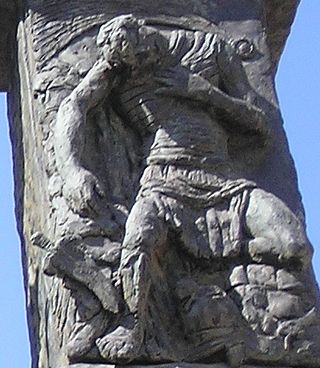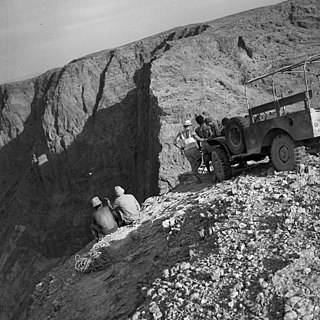
Simon bar Kokhba or Simon bar Koseba, commonly referred to simply as Bar Kokhba, was a Jewish military leader in Judea. He lent his name to the Bar Kokhba revolt, which he initiated against the Roman Empire in 132 CE. Though they were ultimately unsuccessful, Bar Kokhba and his rebels did manage to establish and maintain a Jewish state for about three years after beginning the rebellion. Bar Kokhba served as the state's leader, crowning himself as nasi. Some of the rabbinic scholars in his time imagined him to be the long-expected Messiah of Judaism. In 135, Bar Kokhba was killed by Roman troops in the fortified town of Betar. The Judean rebels who remained after his death were all killed or enslaved within the next year, and their defeat was followed by a harsh crackdown on the Judean populace by the Roman emperor Hadrian.

The Dead Sea Scrolls, also called the Qumran Caves Scrolls, are a set of ancient Jewish manuscripts from the Second Temple period. They were discovered over a period of 10 years, between 1946 and 1956, at the Qumran Caves near Ein Feshkha in the West Bank, on the northern shore of the Dead Sea. Dating from the 3rd century BCE to the 1st century CE, the Dead Sea Scrolls include the oldest surviving manuscripts of entire books later included in the biblical canons, along with extra-biblical and deuterocanonical manuscripts from late Second Temple Judaism. At the same time, they cast new light on the emergence of Christianity and of Rabbinic Judaism. Almost all of the 15,000 scrolls and scroll fragments are held in the Shrine of the Book at the Israel Museum, located in the city of Jerusalem. The Israeli government's custody of the Dead Sea Scrolls is disputed by Jordan and the Palestinian Authority on territorial, legal, and humanitarian grounds—they were mostly discovered following the Jordanian annexation of the West Bank and were acquired by Israel after Jordan lost the 1967 Arab–Israeli War—whilst Israel's claims are primarily based on historical and religious grounds, given their significance in Jewish history and in the heritage of Judaism.

Qumran is an archaeological site in the West Bank managed by Israel's Qumran National Park. It is located on a dry marl plateau about 1.5 km (1 mi) from the northwestern shore of the Dead Sea, about 10 km (6 mi) south of the historic city of Jericho, and adjacent to the modern Israeli settlement and kibbutz of Kalya.

The Bar Kokhba revolt was a large-scale armed rebellion initiated by the Jews of Judea, led by Simon bar Kokhba, against the Roman Empire in 132 CE. Lasting until 135 or early 136, it was the third and final escalation of the Jewish–Roman wars. Like the First Jewish–Roman War and the Second Jewish–Roman War, the Bar Kokhba revolt resulted in a total Jewish defeat; Bar Kokhba himself was killed by Roman troops at Betar in 135 and the Jewish rebels who remained after his death were all killed or enslaved within the next year.

Yigael Yadin was an Israeli archeologist, soldier and politician. He was the second Chief of Staff of the Israel Defense Forces and Deputy Prime Minister from 1977 to 1981.

Emanuel Tov is a Dutch–Israeli biblical scholar and linguist, emeritus J. L. Magnes Professor of Bible Studies in the Department of Bible at the Hebrew University of Jerusalem. He has been intimately involved with the Dead Sea Scrolls for many decades, and from 1991, he was appointed Editor-in-Chief of the Dead Sea Scrolls Publication Project.

The Judaean Desert or Judean Desert is a desert in the West Bank and Israel that lies east of the Judaean Mountains, so east of Jerusalem, and descends to the Dead Sea. Under the name El-Bariyah, it has been nominated to the Tentative List of World Heritage Sites in the State of Palestine, particularly for its monastic ruins.

Robert Eisenman is an American biblical scholar, historian, archaeologist, and poet. He is currently professor of Middle East religions, archaeology, and Islamic law and director of the Institute for the Study of Judaeo-Christian Origins at California State University Long Beach.

4QMMT, also known as MMT, or the Halakhic Letter, is a reconstructed text from manuscripts that were part of the Dead Sea Scrolls discovered at Qumran in the Judean desert. The manuscript fragments used to reconstruct 4QMMT were found in Cave 4 at Qumran in 1953-1959, and kept at the Palestinian Archaeological Museum, now known as the Rockefeller Museum in Jerusalem.
The Isaiah Scroll, designated 1QIsaa and also known as the Great Isaiah Scroll, is one of the seven Dead Sea Scrolls that were first discovered by Bedouin shepherds in 1946 from Qumran Cave 1. The scroll is written in Hebrew and contains the entire Book of Isaiah from beginning to end, apart from a few small damaged portions. It is the oldest complete copy of the Book of Isaiah, being approximately 1000 years older than the oldest Hebrew manuscripts known before the scrolls' discovery. 1QIsaa is also notable in being the only scroll from the Qumran Caves to be preserved almost in its entirety.
Jonas Carl Greenfield was an American scholar of Semitic languages, who published in the fields of Semitic Epigraphy, Aramaic Studies and Qumran Studies, and a distinguished member of the Israel Academy of Sciences and Humanities.
Joseph M. Baumgarten was an Austrian-born Semitic scholar known for his knowledge in the field of Jewish legal texts from biblical law to Mishnaic law and including the legal texts among the Dead Sea Scrolls. Baumgarten immigrated to the United States with his family in 1939 as a result of the Anschluss, Germany's occupation of Austria in 1938. In 1950, he was ordained a rabbi at Mesivta Torah Vodaath, a prominent Brooklyn yeshiva. He married Naomi Rosenberg in 1953.

The Qumran Caves are a series of caves, both natural and artificial, found around the archaeological site of Qumran in the Judaean Desert. It is in these caves that the Dead Sea Scrolls were discovered.
The Qumran cemetery is in eastern Qumran in the West Bank, part of Palestinian area which is under Israeli occupation. It is a large area leading to a descent from which four finger-like ridges point eastward. On these ridges more tombs are located. The current estimate of tombs in the cemetery is over 1100. The largest section, that on the plateau proper, has two east-west paths which divide it into three parts. There are also two small cemeteries near Qumran, one ten minutes' walk north of the main cemetery and one to the south, on the other side of Wadi Qumran.
Carbon dating the Dead Sea Scrolls refers to a series of radiocarbon dating tests performed on the Dead Sea Scrolls, first by the AMS lab of the Zurich Institute of Technology in 1991 and then by the AMS Facility at the University of Arizona in Tucson in 1994–95. There was also a historical test of a piece of linen performed in 1946 by Willard Libby, the inventor of the dating method.
The Yahad Ostracon is a controversial ostracon that was found at the ruins of Qumran in 1996. The editors who published the text claimed that it contained the Hebrew word yahad. This word is also used in a number of the Dead Sea Scrolls, where it has usually been translated as "community", and is generally taken to be a self-reference to the group responsible for the scrolls in which it appears. The presence of this unusual term in both the scrolls and on the ostracon would connect the scrolls to the settlement at Qumran.

Wadi Murabba'at, also known as Nahal Darga, is a ravine cut by a seasonal stream which runs from the Judean Desert east of Bethlehem past the Herodium down to the Dead Sea 18 km south of Khirbet Qumran in the West Bank. It was here in caves that Jewish fighters hid out during the Bar Kochba revolt, leaving behind documents that include some letters signed by Simon Bar Kochba.

Cave of Horror is the nickname given to a refuge cave that archaeologists have catalogued as Nahal Hever Cave 8 (8Hev) of the Judaean Desert, Israel, where the remains of Jewish refugees from the Bar Kokhba revolt were found.

The Te'omim Cave, or the Twins Cave, Arabic name Mughâret Umm et-Tûeimîn, is a karstic cave within a nature reserve in Israel located on the western edges of the Jerusalem Mountains, in the vicinity of Beit Shemesh.

The Bar Kokhba refuge caves are natural caves that were used for shelter by Jewish refugees during the later phases of the Bar Kokhba revolt. Most of the refuge caves were located in the Judaean Desert, nestled within steep cliffs far away from settlements, many overlooking the Dead Sea and the Jordan Valley. Some were also found in ravines flowing into the Dead Sea, while others were nestled within the Judaean Mountains. Unlike the other two hideout systems used by the rebels, the man-made rock-cut hiding complexes, and the hard-to-reach cliff shelters which often contain hewn installations, the refuge caves remained largely untouched by human intervention.














